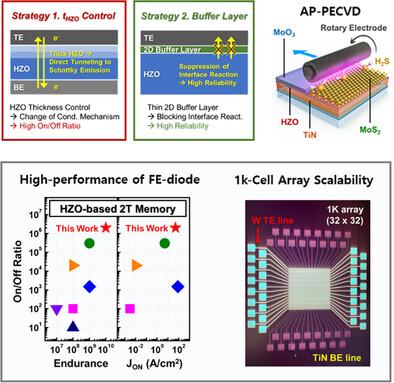High-Performance and Scalable Ferroelectric Diodes Enabled via 2D-MoS2 Buffer Layer Under Low Thermal Budget
IF 12.1
2区 材料科学
Q1 CHEMISTRY, MULTIDISCIPLINARY
引用次数: 0
Abstract
Hafnium-based (Hf0.5Zr0.5O2, HZO) ferroelectrics exhibit robust polarization switching even in ultrathin films and are compatible with atomic layer deposition (ALD), making them promising for two-terminal (2-T) non-volatile memory devices. However, their practical use remains limited by low ON/OFF ratios, high leakage currents, and poor endurance. Herein, A high-performance ferroelectric diode (FE-diode) based on a W/MoS2/HZO/TiN stack is demostrated, fabricated entirely below 400 °C for back-end-of-line (BEOL) compatibility. Two strategies are employed: 1) optimization of the HZO thickness and 2) insertion of a 2D MoS2 buffer layer at the top electrode/ferroelectric interface. Increasing the HZO thickness from 3 to 8 nm changed the dominant conduction mechanism from direct tunneling to Schottky emission, enabling polarization-driven barrier modulation. The MoS2 buffer, synthesized via low-temperature (<300 °C) atmospheric pressure plasma-enhanced CVD, minimized interfacial defects and improved device stability. As a result, the FE-diode exhibited a high current density of 50 A cm−2 (read at 3 V), an electroresistance ratio exceeding 2 × 106, endurance over 1010 cycles, and stable memory retention of 10 years at room temperature. A 1 K (32 × 32) memory array is also demonstrated, confirming excellent scalability and the strong potential of this FE-diode design for next-generation integrated memory applications.

在低热预算下通过2D-MoS2缓冲层实现高性能和可扩展的铁电二极管
基于铪的(Hf0.5Zr0.5O2, HZO)铁电体即使在超薄膜中也表现出稳健的极化开关,并且与原子层沉积(ALD)兼容,使其有望用于双端(2-T)非易失性存储器件。然而,它们的实际使用仍然受到低开/关比,高泄漏电流和耐久性差的限制。本文展示了一种基于W/MoS2/HZO/TiN堆叠的高性能铁电二极管(FE-diode),该二极管完全在400°C以下制造,具有后端线(BEOL)兼容性。采用了两种策略:1)优化HZO厚度和2)在顶部电极/铁电界面插入二维MoS2缓冲层。将HZO的厚度从3 nm增加到8 nm,使主要的传导机制从直接隧穿转变为肖特基发射,从而实现极化驱动势垒调制。通过低温(<300°C)大气压等离子体增强CVD合成的MoS2缓冲液,最大限度地减少了界面缺陷,提高了器件的稳定性。结果表明,该fe二极管具有50 a cm−2的高电流密度(读取电压为3 V),电阻比超过2 × 106,寿命超过1010次,在室温下具有10年的稳定记忆。还演示了1k (32 × 32)存储器阵列,证实了这种fe二极管设计在下一代集成存储器应用中的出色可扩展性和强大潜力。
本文章由计算机程序翻译,如有差异,请以英文原文为准。
求助全文
约1分钟内获得全文
求助全文
来源期刊

Small
工程技术-材料科学:综合
CiteScore
17.70
自引率
3.80%
发文量
1830
审稿时长
2.1 months
期刊介绍:
Small serves as an exceptional platform for both experimental and theoretical studies in fundamental and applied interdisciplinary research at the nano- and microscale. The journal offers a compelling mix of peer-reviewed Research Articles, Reviews, Perspectives, and Comments.
With a remarkable 2022 Journal Impact Factor of 13.3 (Journal Citation Reports from Clarivate Analytics, 2023), Small remains among the top multidisciplinary journals, covering a wide range of topics at the interface of materials science, chemistry, physics, engineering, medicine, and biology.
Small's readership includes biochemists, biologists, biomedical scientists, chemists, engineers, information technologists, materials scientists, physicists, and theoreticians alike.
 求助内容:
求助内容: 应助结果提醒方式:
应助结果提醒方式:


